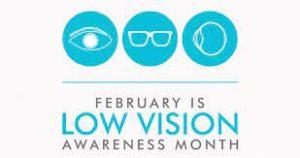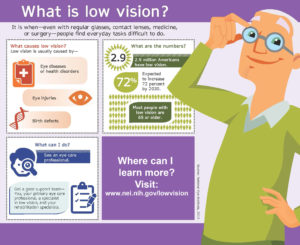Prevent Blindness has declared February as Age-related Macular Degeneration (AMD) and Low Vision Awareness Month. According to the American Academy of Ophthalmology, AMD is a leading cause of vision loss in people 50 years or older, and more than 2.9 million Americans age 40 and older have low vision. Low vision is defined as a visual impairment that is not correctable through surgery, medicine, eye glasses or contact lenses.
According to the National Eye Institute, currently 4.2 million Americans ages 40 and older are visually impaired. Of these, 3 million have low vision. By 2030, when the last baby boomers turn 65, the number of Americans who have visual impairments is projected to reach 7.2 million, with 5 million having low vision.
For the millions of people who currently live or will live with low vision, the good news is that there is help.
But first, what is low vision? Low vision is when even with regular glasses, contact lenses, medicine, or surgery, people have difficulty seeing, which makes everyday tasks difficult to do. Activities that used to be simple like reading the mail, shopping, cooking, and writing can become challenging.
Most people with low vision are age 65 or older. The leading causes of vision loss in older adults are age-related macular degeneration, diabetic retinopathy, cataract, and glaucoma. Among younger people, vision loss is most often caused by inherited eye conditions, infectious and autoimmune eye diseases, or trauma. For people with low vision, maximizing their remaining sight is key to helping them continue to live safe, productive, and rewarding lives.
The first step is to seek help.
What is a low vision specialist? A low vision specialist is an ophthalmologist or optometrist who works with people who have low vision. A low vision specialist can develop a vision rehabilitation plan that identifies strategies and assistive devices appropriate for the person’s particular needs.
A low vision examination is quite different from the basic examination routinely performed by primary care optometrists and ophthalmologists.
A low vision examination includes a review of your visual and medical history, and places an emphasis on the vision needed to read, cook, work, study, travel, and perform and enjoy other common activities. The goals of a low vision exam include assessing the functional needs, capabilities, and limitations of your vision, assessing ocular and systemic diseases, and evaluating and prescribing low vision therapies.
Education and counseling of family and other care providers; providing an understanding of your visual functioning to aid educators, vocational counselors, employers and care givers; directing further evaluations and treatments by other vision rehabilitation professionals; and making appropriate referrals for medical intervention are all a part of a low vision evaluation.
Vision rehabilitation can include the following:
- Training to use magnifying and adaptive devices
- Teaching new daily living skills to remain safe and live independently
- Developing strategies to navigate around the home and in public
- Providing resources and support
The good news is that vision rehabilitation services can help people with vision impairment learn how to stay independent and make the most of their sight. Low Vision Awareness Month is a great time to spread the word about vision rehabilitation — and make sure that people with vision impairment know about the services available to them.
Magnification devices, electronic devices, computer-access software, and other access and mainstream technologies are used to help people with low vision maximize their remaining vision or learn alternative ways to do things, such as using their sense of touch or their sense of hearing.

